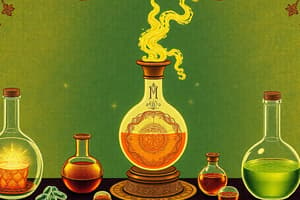Podcast
Questions and Answers
What significant contribution did alchemy provide to chemistry?
What significant contribution did alchemy provide to chemistry?
- Discovery of various minerals
- Isolation of radioactive elements
- Creation of laboratory tools and pure compounds (correct)
- Development of complex chemical equations
In which period was the actual fractionation of alcoholic distillates observed?
In which period was the actual fractionation of alcoholic distillates observed?
- 1800’s
- Pre-1600’s
- 1600’s-1700’s
- 1300’s-1500’s (correct)
Who distinguished between organic and inorganic compounds in the 1700’s?
Who distinguished between organic and inorganic compounds in the 1700’s?
- Friedrich Wöhler
- Antoine Lavoisier
- Hilaire Rouelle
- Torbern Bergman (correct)
What did Hilaire Rouelle achieve in his research?
What did Hilaire Rouelle achieve in his research?
Which chemist is considered the father of organic chemistry?
Which chemist is considered the father of organic chemistry?
What was the main idea of the vis vitalis theory proposed by Jons Jakob Berzelius?
What was the main idea of the vis vitalis theory proposed by Jons Jakob Berzelius?
What significant point did William Brande make about organic and inorganic chemistry?
What significant point did William Brande make about organic and inorganic chemistry?
What did Antoine Lavoisier contribute to modern chemistry?
What did Antoine Lavoisier contribute to modern chemistry?
What is considered the primary focus of organic chemistry?
What is considered the primary focus of organic chemistry?
What concept did Edward Frankland advance in the field of chemistry?
What concept did Edward Frankland advance in the field of chemistry?
Which pair of scientists is known for proposing the 3-D view of molecules?
Which pair of scientists is known for proposing the 3-D view of molecules?
Which type of bonding is primarily associated with carbon compounds?
Which type of bonding is primarily associated with carbon compounds?
What substances are conventionally excluded from the study of organic chemistry despite containing carbon?
What substances are conventionally excluded from the study of organic chemistry despite containing carbon?
What property allows carbon to form a large number of covalent bonds?
What property allows carbon to form a large number of covalent bonds?
Who is known as the father of organic chemistry?
Who is known as the father of organic chemistry?
In the study of chemical bonding, what does 'valence' mean in Latin?
In the study of chemical bonding, what does 'valence' mean in Latin?
What particle carries a positive charge in an atom?
What particle carries a positive charge in an atom?
What term describes atoms with the same atomic number but different mass numbers?
What term describes atoms with the same atomic number but different mass numbers?
In the context of atomic structure, what does the term 'orbital' refer to?
In the context of atomic structure, what does the term 'orbital' refer to?
How many maximum electrons can occupy an s orbital?
How many maximum electrons can occupy an s orbital?
Which of the following is NOT a type of orbital?
Which of the following is NOT a type of orbital?
What does the wave function (represented by ψ) describe in quantum mechanics?
What does the wave function (represented by ψ) describe in quantum mechanics?
Which subshell has the highest number of orbitals?
Which subshell has the highest number of orbitals?
What concept explains the arrangement of electrons in an atom at their lowest energy state?
What concept explains the arrangement of electrons in an atom at their lowest energy state?
What does the Aufbau principle state regarding electron configuration?
What does the Aufbau principle state regarding electron configuration?
In reference to the Pauli exclusion principle, how many electrons can occupy a single orbital?
In reference to the Pauli exclusion principle, how many electrons can occupy a single orbital?
What does Hund's rule dictate about electrons occupying orbitals of equal energy?
What does Hund's rule dictate about electrons occupying orbitals of equal energy?
What is the primary characteristic of organic compounds?
What is the primary characteristic of organic compounds?
What does organic analysis enhance our understanding of?
What does organic analysis enhance our understanding of?
Which of the following statements correctly describes Mercury?
Which of the following statements correctly describes Mercury?
What characteristic is true about Saturn?
What characteristic is true about Saturn?
Which of the following statements best describes Neptune?
Which of the following statements best describes Neptune?
What is true regarding isomers in organic chemistry?
What is true regarding isomers in organic chemistry?
Which of the following best defines organic chemistry according to the content?
Which of the following best defines organic chemistry according to the content?
Which planet is known to have extremely high temperatures?
Which planet is known to have extremely high temperatures?
What percentage of Mars is considered extremely cold according to the provided content?
What percentage of Mars is considered extremely cold according to the provided content?
What is the significance of a quote in the context provided?
What is the significance of a quote in the context provided?
Flashcards are hidden until you start studying
Study Notes
History of Organic Chemistry
- Pre-1600’s: Alchemy
- Led to production methods for pure compounds.
- Invented laboratory tools: beakers, flasks, funnels, crucibles, mortars, pestles, and distillation apparatus.
1300’s-1500’s
- Fractionation of alcoholic distillates marks early organic practices with whisky and brandy.
- Doctors began isolating organic compounds for medicinal purposes, e.g., acetic acid from vinegar and formic acid from ants.
1600’s-1700’s: Birth of Chemistry
-
Torbern Bergman (1770): Distinguished organic from inorganic compounds.
- Organic: from the animal and vegetable world; non-compliance with the Law of Definite Proportions.
- Inorganic: from atmosphere and minerals.
-
Hilaire Rouelle (1780): Isolated urea from urine.
-
Antoine Lavoisier (1789): Established foundations of modern chemistry; identified organic compounds as composed mainly of carbon (C), hydrogen (H), and sometimes nitrogen (N) and phosphorus (P).
-
Jons Jakob Berzelius (1789): Advocated the vitalistic theory, attributing organic compound formation to a vital force in living organisms.
1800’s: Advances in Organic Chemistry
-
Michel Chevreul (1816): Created soap from alkali and animal fat, isolating fatty acids.
-
Friedrich Wöhler (1828): Synthesized urea from ammonium cyanate, pioneering organic synthesis.
-
William Brande (1848): Suggested indistinct lines between organic and inorganic chemistry, focusing on practical learning.
-
Adolph Wilhelm Hermann Kolbe (1840’s): Conducted acetic acid synthesis.
19th Century: Emergence of Organic Chemistry Concepts
-
Edward Frankland (1852): Introduced the concept of valence in chemical bonding.
-
Stanislao Cannizzaro (1858): Utilized Avogadro’s hypothesis to establish accurate molecular weights.
-
A. Kekule & A. Cooper (1850-1860): Developed structural formulas to propose tetravalency of carbon.
-
Emil Erlenmeyer (1850-1860): Introduced the concept of multiple bonding.
-
Kekule’s Dream: Suggested carbon chains can form rings, enhancing understanding of molecular structure.
-
J. van’t Hoff and J. LeBel: Introduced stereochemistry with 3-D molecular perspectives.
20th Century: Modern Chemistry Developments
-
Chemical Bonding (1916):
- Ionic bonding refined by W. Kossel.
- Covalent bonding formalized by G. N. Lewis.
-
Quantum Mechanical Model: Developed by Dirac and Heisenberg, it describes electron behavior in atoms through wave equations.
-
Diversity of Carbon Compounds:
- Carbon bonds strongly with itself and other elements, forming various covalent compounds.
- Compounds like carbon dioxide and carbonate not classified as organic.
Basics of Electronic Configuration
-
Ground-State Configuration: Represents the lowest-energy arrangement of electrons in an atom.
-
Quantum rules for electronic configurations:
- Aufbau principle: Lowest-energy orbitals fill first.
- Pauli exclusion principle: Two electrons per orbital with opposite spins.
- Hund’s rule: Electrons fill degenerate orbitals singly before pairing.
Classes of Organic Compounds
- Organic compounds consist of carbon atoms bonded to hydrogen, and often to oxygen and other elements.
- An understanding of structure contributes to knowledge of organic molecules and their reactive behaviors.
Isomerism
- Isomers: Compounds with the same atom composition but different arrangements and properties.
- The three-dimensional nature of organic chemistry affects molecular properties significantly.
Studying That Suits You
Use AI to generate personalized quizzes and flashcards to suit your learning preferences.




